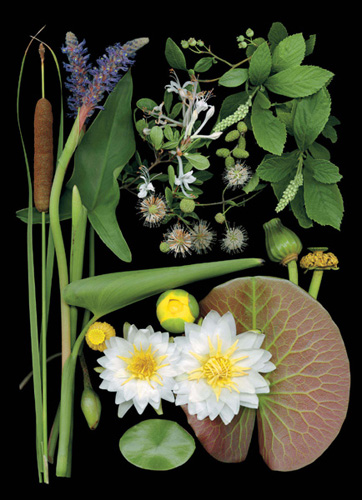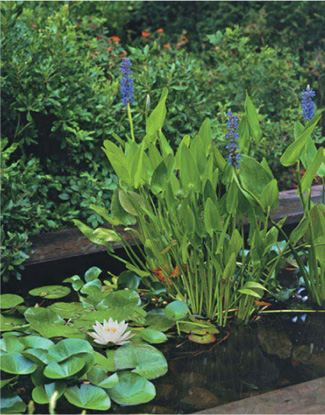
Wetlands range from vernal spring pools to ponds like one in New England where the native plants pictured grew. A Typha angustifolia*; B Pontederia cordata; C Rhododendron viscosum; D Vaccinium corymbosum; E Clethra alnifolia; F Nuphar lutea; G, H Nymphaea odorata; I Peltandra virginica; J Cephalanthus occidentalis.

Wetlands are places where moisture is plentiful for most if not all of the year. These places may be seacoasts, ponds, marshes, fens, vernal pools, bogs, swamps, rivers, lakes, and our own backyard water gardens. These moist environs are filled with wonderful plants and often teaming with wildlife of all kinds.
North America has some amazing native shrubs like azaleas and clethra that grow in moist soil at the water’s edge. Marginal plants include pickerel rush (Pontederia cordata), marsh marigold (Caltha palustris), and lizard’s tail (Saururus cernuus). Floating plants, those with leaves that lie on the surface, include waterlilies (Nymphaea odorata), lotus (Nelumbo lutea), and spatterdock (Nuphar lutea). In the wild, these surface species send roots down into the muck at the shallow bottom.
Some of us lucky gardeners have natural ponds or streams on our properties. The allure of water in the garden inspires more people to bring this element into the landscape. Water in a backyard pond catches a bit of the sky and brings it down to earth. In a shaded urban space, water’s ability to reflect light is a real plus. Imagine the sights and sounds of moving water from a fountain or waterfall. The soothing sound is especially welcome where the whoosh of flowing water can take the edge off traffic noise or mask the whir of an air conditioner.
Wetlands are self-sustaining ecosystems. No such luck for a man-made pond. Just to generate moving water, you must defy gravity. But millions have taken up the challenge. Water gardening is an aspect of our outdoor passion that continues to grow in popularity.
If you are planning on putting in a small pond, make it at least three feet deep, as wide and as long as you have room for, and if you hope to grow flowering plants, site it in full sun. The entire excavation will be lined with rubber sheeting. Marginal plants will go into pots that rest on shelves built into the sides of the artificial pond and also covered by the liner. Floating plants go into large, shallow containers filled with dense clay soil (never humus-based potting mix, which floats). Planted pots with moistened soil are lowered onto supports like large inverted clay pots so their rims are about eighteen inches below the water surface for summer. In cold climates, the pot should be further lowered in the fall to about three feet.
Native plants in a wood frame and rubber-lined “raised bed” water garden.
